Grand Canyon's Mountain Lion Ecology Program Is Tracking Six LionsBy Allyson Mathis 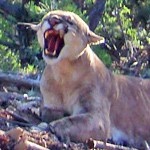
The current mountain lion ecology study at Grand Canyon National Park began in 2003 and, to date, 20 mountain lions have been tracked using both radiotelemetry and global positioning satellite (GPS) data. 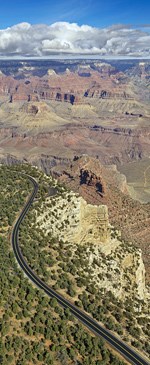
Ron Chapple Photo Grand Canyon National Park wildlife/human interactions biologist Brandon Holton said, “The GPS data permits us to learn aspects about lion behavior that we wouldn’t otherwise be able to study. This data helps us discern each lion’s home range, movement patterns, and habitat use, and investigate kill sites to learn about lions’ prey. This allows us to better understand the mountain lion’s role as the top predator on the southern Colorado Plateau.” The Grand Canyon National Park mountain lion research program has recently partnered with the U.S. Geological Survey’s lion research program in the Flagstaff area and with other national parks on the Colorado Plateau including Zion and Capitol Reef National Parks to gain a broader understanding of lion ecology on the southern Colorado Plateau. Holton explained, “A total of 45 lions have been collared in the four study areas. This larger data set allows wildlife biologists and park managers to have a broader understanding of lions across the region and to see how lions utilize habitat adjacent to human infrastructure in these different areas. 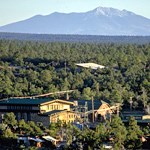
"One of our current areas of emphasis is lion dispersal and the connectivity of lion populations between geographically adjacent study areas such as Grand Canyon and Flagstaff. In fact, one of the first lions collared at Grand Canyon traveled south to Flagstaff and later was killed by a hunter in the San Francisco Peaks area. Another lion trapped on the South Rim traveled to Kendrick Peak near Flagstaff and back to the park. By integrating the different study areas, we hope to better understand how lions use the varied habitat throughout northern Arizona.” 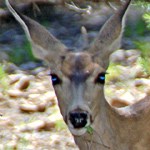
To date, Grand Canyon’s lion study has focused primarily on the South Rim. Data show that mountain lions extensively utilize areas of the forest along the South Rim from the Little Colorado River to Pasture Wash, but that they avoid a small area immediately surrounding the Grand Canyon Village. 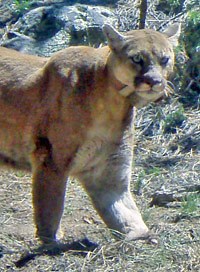
Holton was able to recover her old collar when he recaptured her and has recovered the GPS data that was stored in the collar’s memory. P15 was one of the two lions who had kittens in the summer of 2007 and is the oldest lion being tracked in the study. Holton said, “P15 is definitely a resident female of the Desert View area. Many of the females that we’ve tracked on the South Rim have died young, either by legal hunting outside of the park, disease, or by vehicle collisions. P15 was about 10½ years old when she was first captured, so she is more than 12 years old now.”
The three other lions recently captured in May were male. One of these cats was fitted with a different type of tracking collar that uses the Argos satellite system. An Argos collar transmits the lion’s GPS location to the satellite system each day and the data is in turn sent directly to the researcher on a daily basis.
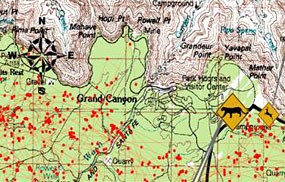
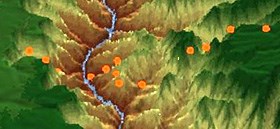
Holton plans to trap and collar three or four mountain lions on the North Rim this summer to begin the first comprehensive study of lions on the north side of the park. In 2005, a female lion collared on the South Rim crossed the canyon to the North Rim. Her collar failed soon thereafter, so park biologists have limited information about her movement patterns. As on the South Rim, the study will focus on predator-prey interactions, population dynamics and survival rates. Holton said, “Since elk aren’t present on the North Rim, we know the lions there will utilize a different prey composition than on the South Rim. Likely, they will predominately use mule deer as their food source. Enlarging the study to the North Rim will greatly increase our understanding of Grand Canyon’s, as well as the southern Colorado Plateau’s, mountain lion population.” 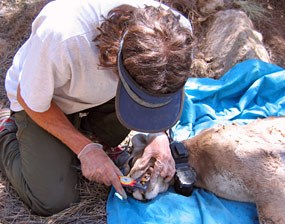
Holton concluded, “This study is important because mountain lions serve as keystone species that help maintain the structure and integrity of ecological communities. As such, particularly information on mountain lion survivability and population dynamics is needed to better manage wildlife communities on a landscape scale.
"The more we understand about these animals, the more information we have to better plan, conserve, and manage these wide-ranging predators in light of current and foreseeable changes on the landscape, with implications cascading beyond the mountain lions themselves.”
Grand Canyon Mountain Lion Program Archive Mountain Lion Research (2009) Download these articles as they appeared in the Summer 2008 Nature Notes (576kb PDF File) Return to the Canyon Sketches Home Page
|
Last updated: January 31, 2017
